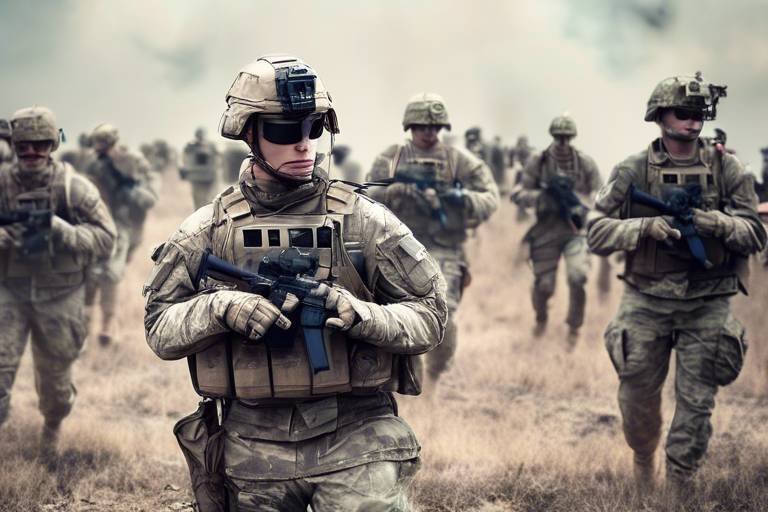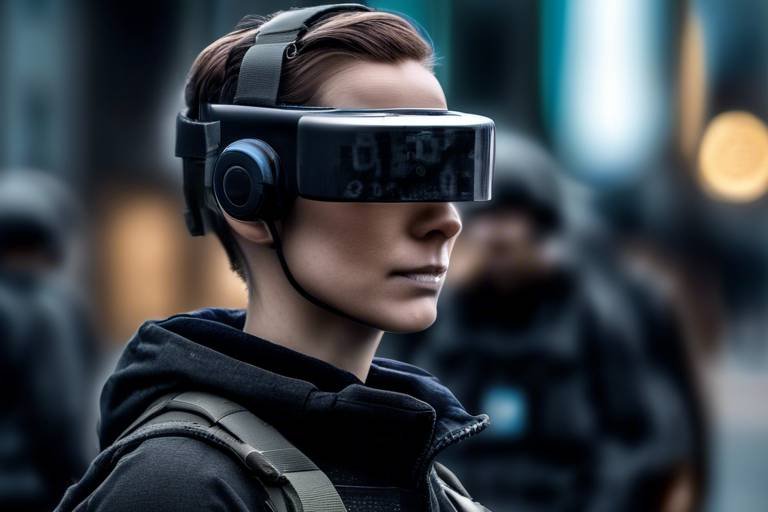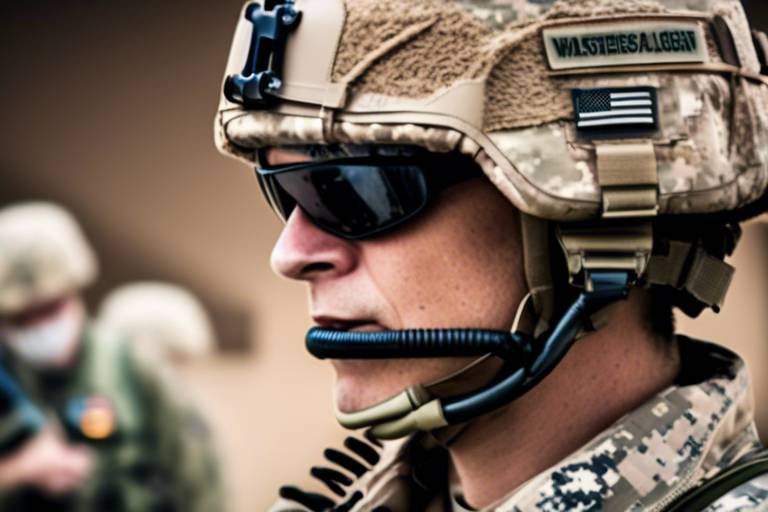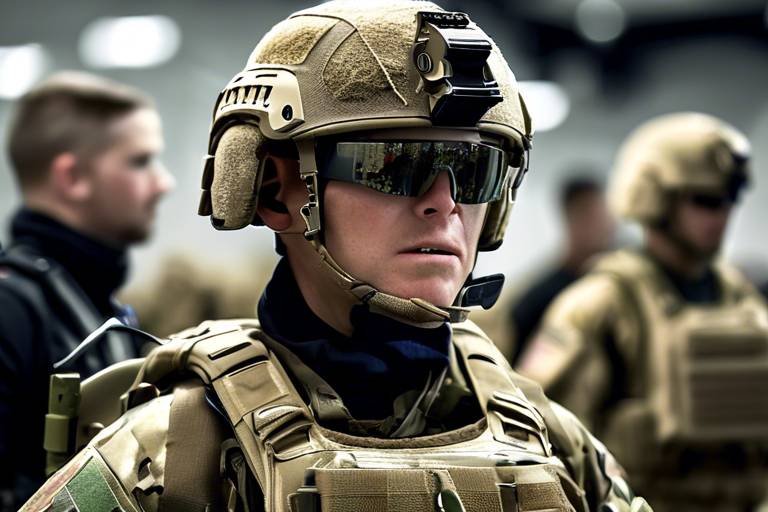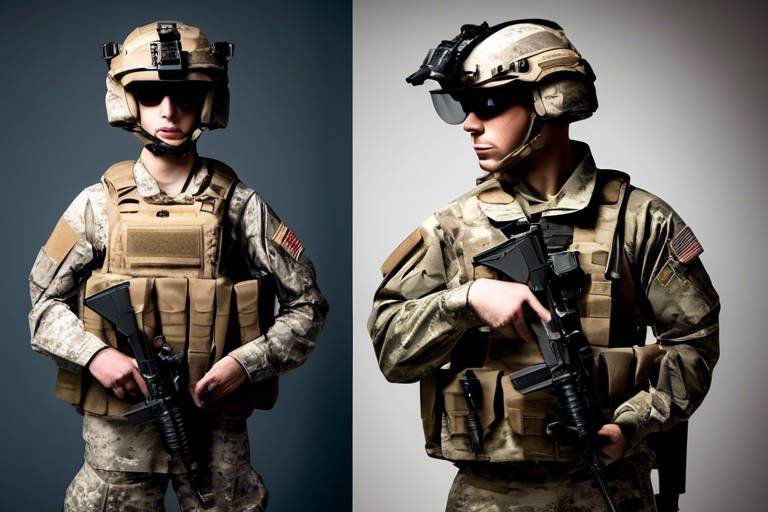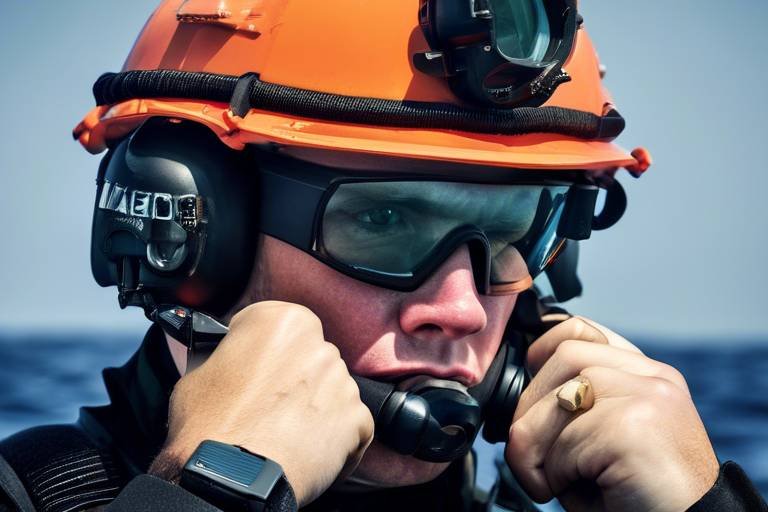The Use of Wearables for Real-Time Battlefield Analysis
In the rapidly evolving landscape of military operations, wearable technology has emerged as a game-changer, transforming how soldiers interact with their environment and make critical decisions in real time. Imagine a battlefield where soldiers are not just equipped with traditional weapons, but also with advanced technology that enhances their situational awareness and operational effectiveness. This article delves into the integration of wearable devices in military settings, highlighting their significance in real-time battlefield analysis.
Wearable technology has revolutionized various industries, including defense. The emergence of these devices marks a significant shift in how military operations are conducted. From smart helmets that provide augmented reality displays to biometric sensors that monitor soldiers' health, wearables are becoming indispensable tools on the battlefield. Their ability to collect and analyze data in real time enables soldiers to make informed decisions, thereby improving mission outcomes and enhancing safety.
In the military realm, a variety of wearable devices are employed to boost operational efficiency. These devices range from smart helmets to biometric sensors, each serving unique functions that contribute to enhanced battlefield analysis. Understanding these devices is crucial for comprehending their impact on military operations.
Smart helmets are at the forefront of wearable technology in defense. Equipped with augmented reality, these helmets provide soldiers with critical information directly in their line of sight. Imagine being in the heat of battle and having access to navigation, communication, and real-time data display all integrated into your helmet. This capability not only aids in decision-making during combat but also significantly enhances situational awareness. As soldiers navigate complex environments, the smart helmet acts as a digital assistant, offering insights that can mean the difference between success and failure.
Biometric sensors are another vital component of wearable technology in military applications. These devices monitor physiological data, such as heart rate, body temperature, and stress levels, providing real-time feedback on a soldier's health and readiness. In high-pressure situations, this information is invaluable; it allows commanders to assess whether troops are fit for duty or need to be rotated out for recovery. By analyzing biometric data, military leaders can make strategic decisions that prioritize the well-being of their personnel while maintaining operational effectiveness.
Wearables significantly improve situational awareness by providing real-time data and analytics. The ability to access critical information instantly allows soldiers to understand their environment better and make informed decisions during combat. Imagine a scenario where a soldier receives live updates about enemy movements or changes in terrain—this level of awareness can drastically alter the course of an operation.
Integrating data from various sources is crucial for effective battlefield analysis. Wearables collect and synthesize information from multiple sensors, offering a comprehensive view of the battlefield. This integration allows for a holistic understanding of the operational landscape, enabling soldiers to respond quickly to evolving threats. With real-time data at their fingertips, troops can adapt their strategies on the fly, enhancing their chances of success.
Effective communication is vital in military operations, and wearable technology enhances this aspect significantly. By facilitating seamless communication among troops, wearables ensure better coordination and response to dynamic battlefield conditions. Imagine being able to communicate with your team without having to rely on bulky radios or complicated systems—wearables streamline this process, allowing for quick and efficient exchanges of information that can save lives.
Despite their numerous benefits, wearable technologies face challenges, including durability and cybersecurity concerns. Military environments are often harsh, and wearables must withstand extreme conditions. Additionally, the sensitive data collected by these devices poses cybersecurity risks that need to be addressed. Solutions such as rugged designs and advanced encryption methods are essential to enhance the reliability of wearables in combat scenarios.
The future of wearable technology in the military is promising, with advancements in AI and machine learning paving the way for even greater capabilities. As these technologies evolve, we can expect wearables to become more intuitive, providing predictive analytics that can anticipate battlefield scenarios. This evolution will not only enhance battlefield analysis but also improve the overall effectiveness of military operations.
- What are some examples of wearable technology used in the military?
Examples include smart helmets, biometric sensors, and tactical vests equipped with communication devices. - How do wearables improve soldier safety?
By providing real-time health monitoring and situational awareness, wearables help ensure soldiers are fit for duty and aware of their surroundings. - What challenges do wearables face in combat?
Challenges include durability, cybersecurity concerns, and the need for reliable data transmission in hostile environments.
1. Introduction to Wearable Technology in Defense
Wearable technology has emerged as a game-changer in various sectors, and the defense industry is no exception. Imagine a soldier on the battlefield equipped not just with weapons, but with advanced technology that enhances their capabilities and keeps them informed in real-time. This is the essence of wearable technology in military operations. These devices, ranging from smart helmets to biometric sensors, are designed to provide critical information at a moment’s notice, ultimately transforming how military personnel operate during missions.
The integration of wearables into defense strategies is not merely a trend; it represents a significant evolution in how forces gather and utilize data on the battlefield. With the ability to monitor health metrics, track movements, and communicate vital information instantaneously, soldiers can make informed decisions that could mean the difference between success and failure in high-stakes environments. The significance of this technology lies in its potential to enhance situational awareness, improve decision-making, and increase the overall effectiveness of military operations.
As we delve deeper into the world of wearable technology in defense, we will explore its various forms and functionalities. This exploration will reveal how these devices are not just gadgets but essential tools that empower soldiers by providing them with the information they need to navigate complex and often chaotic battlefield conditions. Furthermore, we will discuss the implications of these technologies on military strategy and how they can lead to a more coordinated and effective response during operations.
In summary, the adoption of wearable technology in military settings is paving the way for a new era of defense capabilities. With continuous advancements in technology, the future of warfare is likely to be heavily influenced by the integration of these innovative devices. As we move forward, understanding their impact becomes crucial for both military strategists and the general public.
2. Types of Wearable Devices
In the rapidly evolving landscape of military operations, wearable technology has emerged as a game-changer, offering a variety of devices that enhance soldiers' capabilities on the battlefield. These devices are not just gadgets; they are essential tools that provide critical information and support in high-pressure environments. From smart helmets that integrate augmented reality to biometric sensors that monitor health metrics, the types of wearable devices used in military settings are diverse and impactful.
One of the standout innovations in this realm is the smart helmet. Imagine a soldier wearing a helmet that not only protects but also displays vital information right before their eyes. These helmets are equipped with advanced augmented reality systems that allow soldiers to navigate complex terrains, communicate with team members, and access real-time data. For instance, a soldier can receive updates about enemy positions or environmental hazards without needing to divert their attention from their immediate surroundings. This capability is crucial for making quick and informed decisions during combat.
On the other hand, biometric sensors play a pivotal role in monitoring the physical and mental state of soldiers. These sensors track various physiological parameters, such as heart rate, temperature, and stress levels. By analyzing this data, military leaders can assess a soldier's readiness for combat and overall health. For example, if a soldier's heart rate spikes or their stress levels rise significantly, it may signal the need for a break or medical attention. This real-time health monitoring is akin to having a personal trainer and a doctor on the battlefield, ensuring that soldiers are fit to fight.
To give you a clearer picture of the different types of wearables, here’s a brief overview:
| Device Type | Functionality |
|---|---|
| Smart Helmets | Augmented reality displays, navigation, communication |
| Biometric Sensors | Health monitoring, stress assessment, readiness evaluation |
| Smart Glasses | Visual data overlay, target identification, situational awareness |
| Wearable Cameras | Real-time video streaming, reconnaissance, evidence collection |
In addition to smart helmets and biometric sensors, other wearable devices like smart glasses and wearable cameras are becoming increasingly prevalent. Smart glasses can overlay visual data directly onto the soldier's field of view, enhancing situational awareness and allowing for quick target identification. Meanwhile, wearable cameras provide real-time video feeds that can assist in reconnaissance missions and serve as valuable evidence in post-operation analyses.
As we delve deeper into the world of wearable technology, it becomes evident that these devices are more than just trends; they are vital components of modern military strategy. By integrating these technologies into everyday operations, the military can significantly enhance its effectiveness, ensuring that soldiers are not only well-equipped but also well-informed.
2.1 Smart Helmets
Smart helmets are at the forefront of wearable technology in military operations, acting as a game changer for soldiers on the battlefield. Imagine a soldier donning a helmet that not only protects but also enhances their situational awareness through augmented reality (AR). These helmets are equipped with a variety of advanced features that provide critical information in real-time, allowing soldiers to make informed decisions under pressure.
One of the standout functionalities of smart helmets is their ability to display navigation aids. Using integrated GPS technology, soldiers can receive turn-by-turn directions directly in their line of sight. This is crucial in combat scenarios where every second counts and getting lost can have dire consequences. Moreover, smart helmets can also deliver communication capabilities, allowing troops to stay connected with their command units and fellow soldiers without the need for handheld devices. This hands-free communication is vital, especially when soldiers are engaged in intense activities.
Furthermore, smart helmets can integrate various data feeds from sensors, such as environmental conditions and enemy movements. For instance, if there is a sudden change in weather or a nearby threat, the helmet can alert the soldier instantly. This integration of information not only enhances situational awareness but also fosters a proactive approach to battlefield management.
To illustrate the capabilities of smart helmets, consider the following table that outlines their primary features:
| Feature | Description |
|---|---|
| Augmented Reality Display | Overlays critical information directly in the soldier's field of vision. |
| GPS Navigation | Provides real-time navigation to ensure troops stay on course. |
| Communication Systems | Facilitates hands-free communication with command and other soldiers. |
| Data Integration | Collects and displays data from various battlefield sensors. |
In essence, smart helmets are not just protective gear; they are integral tools that empower soldiers by enhancing their awareness and decision-making capabilities. As technology continues to evolve, we can only anticipate even more sophisticated features that will further elevate the role of smart helmets in military operations.
2.2 Biometric Sensors
Biometric sensors have emerged as a game-changer in military operations, offering a unique way to monitor the physiological state of soldiers in real-time. Imagine being able to assess a soldier's heart rate, stress levels, and even fatigue without interrupting their mission. This technology allows commanders to gain insights into their troops' physical conditions, which is crucial in high-pressure environments where every second counts.
These sensors can be embedded in various wearable devices, such as smart uniforms or wristbands, and they continuously collect data that can be transmitted back to central command or displayed on a soldier's smart device. For instance, if a soldier's heart rate spikes unexpectedly, it could indicate heightened stress or potential health issues. This information can prompt immediate intervention, ensuring that soldiers are fit for duty and capable of performing at their best.
Moreover, biometric sensors can help in assessing overall soldier readiness. By analyzing trends in physiological data over time, military leaders can identify patterns that may indicate when a soldier is becoming overwhelmed or fatigued. This proactive approach can lead to better resource allocation, allowing for timely rest and recovery, which ultimately enhances operational effectiveness.
Here's a quick overview of some key metrics that biometric sensors can monitor:
| Metric | Description |
|---|---|
| Heart Rate | Tracks the soldier's heart rate to assess physical exertion and stress levels. |
| Body Temperature | Monitors body temperature to detect signs of heat stress or illness. |
| Oxygen Levels | Measures oxygen saturation in the blood, crucial for ensuring soldiers are not at risk of hypoxia. |
| Fatigue Levels | Analyzes data to predict fatigue, enabling timely breaks to maintain peak performance. |
In summary, biometric sensors are not just about collecting data; they are about enhancing the safety and effectiveness of military personnel. By leveraging this technology, military operations can transition from reactive to proactive, ensuring that soldiers are always at their optimal performance levels. This shift not only improves individual soldier health but also contributes to the overall success of missions on the battlefield.
3. Enhancing Situational Awareness
In the chaotic environment of a battlefield, situational awareness can be the difference between life and death. Wearable technology plays a pivotal role in enhancing this awareness by providing soldiers with real-time data and analytics. Imagine being in a high-pressure situation where every second counts; having immediate access to crucial information can empower soldiers to make informed decisions swiftly. Wearables collect data from various sources, synthesizing it to create a comprehensive view of the battlefield. This integration of technology not only streamlines information flow but also helps in anticipating potential threats and opportunities.
One of the most significant advantages of wearables is their ability to integrate data from multiple sensors. These devices can gather information on environmental conditions, enemy movements, and even the physiological state of the soldiers themselves. For example, a smart helmet might display real-time maps, highlighting enemy positions and safe routes, while simultaneously monitoring the soldier's heart rate and stress levels. This multifaceted approach to data collection ensures that soldiers are not only aware of their immediate surroundings but are also equipped with insights that can guide their actions. In essence, wearables transform raw data into actionable intelligence, allowing soldiers to react with precision.
Moreover, effective communication is vital in military operations, and wearable technology significantly enhances this aspect. Soldiers equipped with wearables can communicate seamlessly with their units, sharing critical information instantly. This capability is especially important in dynamic battlefield conditions where circumstances can change rapidly. Imagine a scenario where a squad member spots an enemy ambush; with wearable tech, they can alert their team in real-time, enabling a coordinated response. The reduction in communication lag can drastically improve response times and operational effectiveness.
Furthermore, the integration of wearables into military operations facilitates team cohesion. When every member of a unit has access to the same real-time data, it fosters a shared understanding of the battlefield situation. This collective awareness is crucial when executing complex maneuvers, as it ensures that all team members are on the same page. The result is a more synchronized approach to combat, where soldiers can rely on one another, enhancing both their confidence and effectiveness.
However, while the benefits of wearables are compelling, it’s essential to recognize that they are not without challenges. Issues such as battery life, durability, and cybersecurity need to be addressed to ensure that these devices function optimally in the harsh conditions of a battlefield. Nevertheless, the potential for wearables to enhance situational awareness is immense, making them a critical component of future military operations.
- What types of data do wearables collect? Wearables collect various types of data, including environmental conditions, soldier health metrics, and tactical information.
- How do wearables improve communication among troops? Wearables enable real-time communication, allowing soldiers to share critical information instantly, which enhances coordination and response times.
- What are the main challenges faced by wearable technology in the military? The primary challenges include durability, battery life, and cybersecurity concerns that need to be addressed for effective use in combat.
- Can wearables be used for training purposes? Yes, wearables can be utilized in training scenarios to monitor soldiers' performance and physiological responses, helping to improve overall readiness.
3.1 Data Integration
In the fast-paced realm of military operations, data integration is not just a luxury; it's a necessity. Imagine a soldier on the battlefield, equipped with a variety of sensors and devices, each collecting vital information. The challenge lies in merging this data into a single, coherent picture that enhances situational awareness. Wearable technology plays a pivotal role here, acting as a central hub that gathers and synthesizes information from multiple sources. This integration allows soldiers to access real-time analytics, which is crucial for making informed decisions under pressure.
For instance, a smart helmet can pull data from environmental sensors, GPS devices, and even biometric monitors. This data amalgamation provides a comprehensive view of the battlefield, allowing soldiers to understand not just where they are, but also the condition of their fellow troops and the surrounding environment. The ability to visualize this information in real-time can be the difference between life and death. A soldier can see enemy positions, friendly troop locations, and potential hazards all at a glance, making the chaotic battlefield feel a little less overwhelming.
Moreover, the integration of data enhances communication among troops. With wearables, a soldier can instantly share critical information with their team, ensuring everyone is on the same page. This can be particularly important during dynamic situations where conditions can change rapidly. For example, if a soldier detects an enemy movement, they can alert their unit immediately, allowing for a coordinated response. Such real-time updates can significantly improve the effectiveness of military operations.
However, achieving seamless data integration is not without its challenges. Issues related to data compatibility and cybersecurity must be addressed. Different devices may use various communication protocols, making it difficult to share information effectively. Furthermore, with the increasing reliance on digital systems, the risk of cyber threats grows. Ensuring that data is transmitted securely and remains intact is crucial for operational success. To tackle these challenges, military organizations are investing in advanced encryption methods and standardized communication protocols, paving the way for a more integrated approach to battlefield analysis.
In conclusion, the integration of data through wearable technology is revolutionizing how soldiers perceive and react to their environment. By synthesizing information from various sources, wearables not only enhance situational awareness but also foster improved communication and coordination among troops. As technology continues to evolve, the potential for even greater integration and analysis in real-time will undoubtedly shape the future of military operations.
- What are wearable devices in the military? Wearable devices in the military include smart helmets, biometric sensors, and other technologies designed to enhance situational awareness and decision-making.
- How does data integration improve battlefield analysis? Data integration allows soldiers to access real-time information from multiple sources, providing a comprehensive view of the battlefield and enhancing decision-making.
- What challenges does data integration face? Challenges include data compatibility, cybersecurity threats, and the need for standardized communication protocols among various devices.
- What is the future of wearable technology in the military? The future includes advancements in AI and machine learning, which will further enhance the capabilities of wearable technology in military operations.
3.2 Communication Improvements
In the heat of battle, communication can be the difference between victory and defeat. Wearable technology has emerged as a game-changer in this arena, significantly enhancing how soldiers communicate on the battlefield. Imagine a scenario where a squad is operating in a dense forest, with visibility limited and the enemy lurking around every corner. Traditional communication methods can falter, but with wearables, soldiers can stay connected seamlessly, sharing vital information in real-time.
One of the standout features of wearable devices is their ability to provide instant updates and alerts. For instance, smart helmets equipped with augmented reality can display crucial data directly in a soldier's field of vision. This functionality allows troops to receive messages, coordinates, and even tactical maps without needing to fumble for a radio or smartphone. The information is right there, integrated into their line of sight, allowing for quicker decision-making and a more coordinated response to threats.
Moreover, these devices often come with advanced communication systems that utilize secure channels, ensuring that sensitive information remains protected from enemy interception. In a world where information warfare is prevalent, maintaining the integrity of communication is paramount. Wearable technology not only enhances the speed of communication but also fortifies its security, allowing soldiers to focus on their mission without the constant worry of being compromised.
Additionally, the integration of voice recognition and hands-free operation into these wearables cannot be overstated. Soldiers can communicate with their team while keeping their hands free for other tasks, such as operating weapons or navigating difficult terrain. This hands-free capability is crucial during high-stress situations where every second counts. Imagine a soldier needing to relay enemy positions or call for backup while simultaneously engaging in combat; wearables make this possible.
Furthermore, the ability to communicate across different units and branches of the military enhances overall operational effectiveness. Wearable devices can connect various platforms, allowing for a unified communication network that transcends traditional barriers. This interconnectedness fosters better collaboration among units, leading to a more synchronized approach to battlefield tactics.
In summary, the advancements in wearable technology have revolutionized communication on the battlefield. With features that enhance speed, security, and ease of use, these devices empower soldiers to operate more effectively in high-pressure environments. As we continue to innovate and integrate technology into military operations, the potential for improved communication will only expand, ultimately leading to greater success in missions.
- What types of wearable devices are used in the military? Wearable devices in the military include smart helmets, biometric sensors, and communication devices that enhance situational awareness and operational effectiveness.
- How do wearables improve communication among troops? Wearables provide real-time updates, secure communication channels, and hands-free operation, allowing soldiers to stay connected and informed while engaged in combat.
- What are the security concerns associated with wearable technology? Security concerns include the potential for data interception and unauthorized access to sensitive information. However, advancements in encryption and secure communication protocols are addressing these issues.
- Can wearables help in assessing soldier health during combat? Yes, biometric sensors integrated into wearables can monitor vital signs, allowing commanders to assess soldier readiness and health in real-time, which is crucial in high-stress situations.
4. Challenges and Limitations
While the integration of wearable technology in military operations presents a myriad of advantages, it is essential to acknowledge the challenges and limitations these devices face in real-world scenarios. One of the primary concerns is the durability of wearables. In a combat environment, where conditions can be harsh and unpredictable, these devices must withstand extreme temperatures, moisture, and physical impacts. For instance, a soldier's smart helmet may be rendered useless if it can't endure a sudden downpour or a rough tumble during a mission.
Another significant challenge is cybersecurity. As wearables become more interconnected, they are increasingly vulnerable to hacking and data breaches. Imagine a scenario where enemy forces intercept sensitive data from a soldier's biometric sensor, which could reveal critical information about troop movements or health status. This potential for exploitation raises serious concerns about the safety and integrity of military operations.
Moreover, the user interface of these devices must be intuitive and easy to navigate under pressure. Soldiers are often required to make split-second decisions, and if a wearable device is cumbersome or complicated, it could lead to disastrous consequences. Therefore, developers must prioritize usability alongside functionality when designing these technologies.
To further illustrate these challenges, consider the following table that outlines some of the key issues faced by wearable technology in military applications:
| Challenge | Description |
|---|---|
| Durability | Wearables must withstand extreme environmental conditions and physical impacts. |
| Cybersecurity | Increased connectivity raises the risk of data breaches and hacking. |
| User Interface | The interface must be intuitive to ensure quick decision-making in high-pressure situations. |
In addition to these challenges, there are also concerns regarding the reliability of the data collected by wearables. If the sensors malfunction or provide inaccurate readings, it could mislead soldiers and commanders, leading to poor tactical decisions. For example, if a biometric sensor inaccurately reports a soldier's heart rate as stable when they are actually experiencing high stress, it could compromise their effectiveness in the field.
Finally, the cost of developing and maintaining these advanced technologies cannot be overlooked. Budget constraints in military operations often limit the number of wearables that can be deployed, which means that not every soldier may have access to these life-saving tools. This disparity can create uneven advantages on the battlefield, where some units are equipped with cutting-edge technology while others rely on outdated methods.
In conclusion, while wearable technology offers transformative potential for battlefield analysis, it is crucial to address these challenges to maximize their effectiveness. By focusing on enhancing durability, strengthening cybersecurity measures, ensuring user-friendly interfaces, and maintaining data reliability, the military can better leverage these innovations for improved operational success.
- What are the main benefits of using wearables in military operations?
Wearables enhance situational awareness, improve communication, and monitor soldier health in real-time. - How do wearables improve decision-making on the battlefield?
They provide critical data and analytics that help soldiers make informed choices quickly. - What steps are being taken to address cybersecurity concerns?
Military organizations are investing in advanced encryption and security protocols to protect data. - Are there any ongoing developments in wearable technology for the military?
Yes, advancements in AI and machine learning are expected to enhance the capabilities of wearables in the future.
5. Future Trends in Wearable Technology
The landscape of wearable technology in the military is evolving at a breakneck pace, driven by advancements in artificial intelligence (AI) and machine learning. These technologies are not just buzzwords; they represent a significant leap forward in how soldiers interact with their environment and make decisions in real-time. Imagine a battlefield where your gear not only tracks your health but also predicts your next move based on the data it collects. This is not science fiction; this is the future of military wearables.
One of the most exciting trends is the integration of AI-driven analytics. Wearable devices will soon be able to analyze vast amounts of data on the fly, providing soldiers with actionable insights that can change the course of a mission. For instance, a smart helmet could process data from multiple sensors, including environmental conditions, troop movements, and even enemy positions, to give a soldier a comprehensive overview of the battlefield in seconds. This capability could mean the difference between life and death in critical situations.
Moreover, the incorporation of augmented reality (AR) into wearable devices is set to revolutionize training and operational efficiency. Imagine wearing a smart visor that overlays critical information directly onto your field of view. This could include tactical maps, enemy locations, and even instructions from command, all while keeping your hands free for combat. Such immersive technology will not only enhance situational awareness but also streamline communication among troops, making coordinated attacks more effective.
As we look to the future, we can also expect significant improvements in the durability and cybersecurity of wearable devices. Military operations often take place in harsh environments, where equipment must withstand extreme conditions. Future wearables will likely be designed with advanced materials that are not only lightweight but also resistant to water, dust, and shock. At the same time, cybersecurity will be at the forefront of development, ensuring that sensitive data transmitted between devices remains secure from potential threats.
In addition to these advancements, the use of biometric monitoring will become more sophisticated. Wearables will be able to track not just heart rate and stress levels but also other vital signs like blood oxygen levels and fatigue indicators. This data can be crucial for assessing a soldier's readiness and overall health in high-pressure situations. By leveraging real-time health data, commanders can make informed decisions about troop deployments and interventions.
Ultimately, the future of wearable technology in the military is not just about enhancing individual capabilities; it's about creating a connected ecosystem where every soldier's device communicates with others. This interconnectedness will lead to a more cohesive operational strategy, allowing troops to respond more effectively to dynamic battlefield conditions. As we embrace these innovations, we are not just preparing for the future; we are shaping it.
- What are the primary benefits of wearable technology in military operations? Wearable technology enhances situational awareness, improves communication, and provides real-time health monitoring, leading to better decision-making on the battlefield.
- How does artificial intelligence improve wearable devices? AI enables wearables to analyze data quickly, providing soldiers with actionable insights and predictive analytics that can enhance mission effectiveness.
- What challenges do wearables face in combat environments? Durability and cybersecurity are significant concerns, as devices must withstand harsh conditions while protecting sensitive data from potential threats.
- Will augmented reality be widely used in military wearables? Yes, augmented reality is expected to play a crucial role in future wearable technology, providing soldiers with critical information directly in their line of sight.
Frequently Asked Questions
- What are wearable technologies in the military?
Wearable technologies in the military refer to devices that soldiers can wear to enhance their operational capabilities. These include smart helmets, biometric sensors, and communication devices that provide real-time data and analytics to improve situational awareness and decision-making.
- How do smart helmets improve battlefield analysis?
Smart helmets are equipped with augmented reality features that display critical information such as navigation, troop locations, and mission data. This real-time information helps soldiers make informed decisions quickly, ultimately enhancing their effectiveness during combat.
- What role do biometric sensors play in military operations?
Biometric sensors monitor vital signs like heart rate and stress levels, providing insights into a soldier's physical and mental state. This data can be crucial for assessing readiness and ensuring that troops are in optimal condition during high-pressure situations.
- How do wearables enhance situational awareness?
Wearables enhance situational awareness by collecting and integrating data from multiple sources, such as GPS, environmental sensors, and communication devices. This comprehensive view allows soldiers to understand their surroundings better and respond effectively to dynamic battlefield conditions.
- What are the communication benefits of wearable technology?
Wearable technology improves communication among troops by providing instant connectivity and access to information. This facilitates better coordination, quicker responses, and a more synchronized approach to military operations, which is essential in fast-paced environments.
- What challenges do wearable technologies face in combat?
Despite their advantages, wearable technologies encounter challenges such as durability in harsh conditions, battery life, and cybersecurity threats. Addressing these issues is crucial for ensuring the reliability and safety of wearables in military settings.
- What does the future hold for wearable technology in the military?
The future of wearable technology in the military looks promising, with advancements in artificial intelligence and machine learning. These technologies could lead to even more sophisticated wearables that enhance battlefield analysis, improve soldier safety, and increase operational efficiency.

